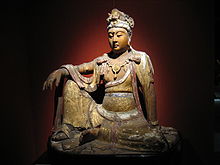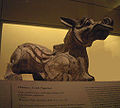China
Artifacts from China date back as early as 10,000 BC and skilled Chinese artisans had been active very early in history, but the bulk of what is displayed as sculpture comes from a few select historical periods. The first period of interest has been the Western Zhou Dynasty (1050-771 BC), from which come a variety of intricate cast bronze vessels. The next period of interest was the Han Dynasty (206 BC-220 AD), beginning with the spectacular Terracotta Army assembled for the tomb of Qin Shi Huang, the first emperor of the important but short-lived Qin Dynasty that preceded the Han. Tombs excavated from the Han period have revealed many figures found to be vigorous, direct, and appealing 2000 years later.
The first Buddhist sculpture is found dating from the Three Kingdoms period (3rd century), while the sculpture of the Longmen Grottoes near Luoyang, Henan Province (Northern Wei, 5th and 6th century) has been widely recognized for its special elegant qualities.
A wooden Bodhisattva from the Song Dynasty (960-1279)
The period now considered to be China's golden age is theTang Dynasty, coinciding with what in Europe is sometimes called the Dark Ages). Decorative figures like those shown below became very popular in 20th century Euro-American culture, and were made available in bulk, as warlords in the Chinese civil wars exported them to raise cash. Considered especially desirable, and even profound, was the Buddhist sculpture, often monumental, begun in the Sui Dynasty, inspired by the Indian art of the Gupta period, and many are considered treasures of world art.
Following the Tang, Western interest in Chinese artifacts drops off dramatically, except for what might be considered as ornamental furnishings, and especially objects in jade. Pottery from many periods has been collected, and again the Tang period stands out apart for its free, easy feeling. Chinese sculpture has no nudes—other perhaps than figures made for medical training or practice—and very little portraiture compared with the European tradition. One place where sculptural portraiture was pursued, however, was in the monasteries.
Almost nothing, other than jewelry, jade, or pottery is collected by art museums after the Ming Dynasty ended in the late 17th century—and absolutely nothing has yet been recognized as sculpture from the tumultuous 20th century, although there was a school of Soviet-influenced social realist sculpture in the early decades of the Communist regime, and as the century turned, Chinese craftsmen began to dominate commercial sculpture genres (the collector plates, figurines, toys, etc) and avant garde Chinese artists began to participate in the Euro-American enterprise of contemporary art.
Wine jar, Western Zhou Dynasty (1050 BC-771 BC) | Calvalryman, Qin Dynasty | Terracotta Army soldier and horse from the Qin Dynasty | Chimera (from a tomb) ,Han Dynasty (202 BC-220 AD) |
Tomb figure, Han Dynasty(202 BC-220 AD) | Northern Wei DynastyMaitreya (386-534) | Tang Dynasty rider (618-907) | Tang Dynasty girl figurine (618-907) |
Boddisatva, Tang Dynasty(618-907) | The Leshan Giant Buddha,Tang Dynasty, completed in 803. | Portrait of monk, Song Dynasty, 11th century | |
A wooden Bodhisattvafrom the Song Dynasty(960-1279) | A glazed stoneware statue,Ming Dynasty (16th century) | Blue underglaze statue of a man with his pipe, fromJingdezhen, Ming Dynasty(1368-1644) | |
Doctor's lady, mid-19th century |




















0 comments:
Post a Comment
If U like this post then give me a comments about this post